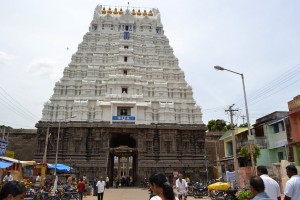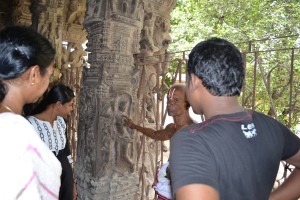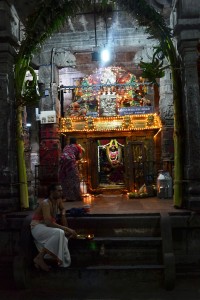Kami L. Rice concludes her guest series, Heading East, this week.

Standing in an ancient Hindu temple that honors Vishnu—or perhaps it was a temple for one of the other Hindu gods, or maybe it was for one of Vishnu’s avatars; it’s hard to remember for sure because it’s so very hard to keep Hinduism’s less-than-codified beliefs straight—and watching people seek blessings from whichever god’s statue it was that was open for business at that time of day, I felt an unexpected desire to wretch.
The temple, located in the temple city Kanchipuram outside Chennai, the capitol of Tamil Nadu, was at least 1,500 years old, which means that for 1,500 years people have been coming to that place to worship and seek blessings from variously-imaged gods. More than that, it means that for more than 1,500 years the people of India have been enslaved in a belief system that most don’t know enslaves them.

The memory of viewing and touching the huge temple’s intricately carved stone is a souvenir that returned to America with me this week. That souvenir is a reminder of the depth of the spiritual strongholds that persist in India, strongholds that elicited that physical instinct from me to wretch over what was represented there.
A few days later, one of my new Indian friends, a Christian, noted over dinner that one of the challenges of sharing the Good News in India is Hinduism’s deep roots. I understood her comment so much better for having toured temples a week earlier. You can’t separate India’s ancient cultural achievements from its history of worship of these gods. The gods and their images seem to permeate nearly everything.

A few years ago, soon after completing an article for a Nashville arts magazine about the history and current state of the Judeo-Christian tradition’s relationship with the arts, I was in London wandering through the National Gallery and National Portrait Gallery. Courtesy of my recently completed crash course in art history, I was primed to notice how much Christian religious imagery dominated earlier paintings, in particular. Wandering through temples and cultural sites in India, I was struck by the contrast in belief that’s recorded in India’s art.
During dinner, my new friend noted that sharing Christ with Hindu friends must be done delicately. If someone comes and tells you that what you’ve always believed is wrong, you’re going to be defensive, she said, noting that God must first open their hearts and make them curious.
At Bishop Appasamy College, I met the Christian Leadership Team, a student group that plans chapels and receives training in ministry leadership. In response to a question from me about how they share their faith, one student replied that it’s not about telling people about Jesus but about living it. Another student added that people don’t want to hear about Jesus, they want to see Him.
The anti-conversion laws in some of India’s states (laws that officially are intended to curb “forcible conversions” but that often include dangerous and unjustly wide interpretations of “forcible”) cause many believers in India to have legal and personal-protection incentive for recognizing the delicacy of sharing the gospel with their Hindu friends and for living their faith more than talking about it. Nonetheless, it still seems these particular brothers and sisters of ours are quite matter-of-fact about something we can sometimes ignore because we live in a place that doesn’t have anti-conversion laws.

My dinner friend also mentioned the importance of prayer in the process of sharing the gospel. She has first-hand experience of its power. After her older sister became a believer through the work of the IFES group in India, UESI (Union of Evangelical Students of India), my friend followed, and then both girls prayed for the rest of their family to accept Jesus. Within a few years, their parents and other two sisters had done just that. Now they’re praying for their extended family.
Still, by and large, in my conversations with Indian believers these past few weeks, I actually found most often that despite the existence of anti-corruption laws, despite being a minority religious group in India, despite living in a place with such a very deep foundation in another belief system, Indian believers really aren’t so different from American believers. They aren’t necessarily any more spiritual than us. They struggle with many of the same things we do, such as being diligent in studying God’s word, diligent in prayer, and discerning in how to be Christ’s ambassadors in their workplaces and neighborhoods and families.
The details of our cultures are different, but much about our life in Christ is similar. In many ways, that should make it easier for us to pray for each other.
I’ve come away from India more fascinated by the place, more aware than ever that a few weeks is not long enough to really understand its context, and more convinced of the necessity of God’s power, accessed through prayer, to break India’s spiritual strongholds.
All photos by Kami L. Rice.
Based in Nashville, Tenn., Kami Rice (www.kamirice.com) became a fan of avocadoes in Kenya, olives in England and Italy, tilapia in Uganda, mangoes in Haiti and Indian chai in, well, India. Since 2007, she has worked full-time as a freelance writer. She also served briefly as a part-time member of InterVarsity’s Graduate & Faculty Ministries team. She’s also blogging from India at www.kami-in-africa.blogspot.com.

“…more convinced of the necessity of God’s power, accessed through prayer, to break ______’s spiritual strongholds…”
Yes! Amen…
If you studied Hinduism you realise it’s all one Supreme god it’s just your level of understanding leads you to believe that Hindus worship multi gods but it’s really all one god. See a hindu can look at a church or a mosque or any other place of worship and see god and it’s reflected of that individual. Maybe you should read the Vedanta also the Bharat vita. Also ask a reputable Hindu they will tell you there is a spirit in everything
Also I was raised a Christian and I also studied the bible christiantys core beliefs also read Vedanta and I can tell the level of understanding of Hinduism is quite limited. Your need to try and convert everyone to Christianity in India shows you don’t understand Hinduism here is a link http://www.leicestersecularsociety.org.uk/docs/20090222%20anil.pdf
Mitchell,
Thanks for weighing in. I’m not sure about Kami, but I have studied Hinduism, as well as many other religions. You’re right: Vedantic Hinduism sees the gods as manifestations of the world-soul. That’s not the position of all schools of Hinduism, which is a very complex and mixed group of beliefs.
I read the paper you linked to. Anil Bhanot critiques Christianity and atheism because they view only one path as right…and then he suggests that only Hinduism offers the right path. I’m really not sure what to do with that. In another paper, Bhanot calls for missionary activity to be made a crime against humanity under international law:
Do you agree with Bhanot that Kami should be put on trial by an international court for her blog post above? That doesn’t sound very tolerant to me.
More importantly, neither I nor anyone in InterVarsity (if I may be so bold) want to see anyone “convert to Christianity,” if you mean by that to adopt Western culture and simply replace one system for another. We DO want to see others follow Jesus and come to him, to have their sins forgiven and to receive new life. As I have studied Indian religion, it seems quite similar to the Greek and Roman religion confronted by the early church. Getting right with the gods was a matter of either performing the right kinds of religious devotions, living up to the right kinds of moral codes, or thinking the right kinds of philosophical thoughts…but, of course, you were only right with the gods for the short amount of time that you were doing or thinking the right thing. Then you had to start all over again.
Jesus offered them freedom from this relentless cycle through his death and resurrection, and he offers the same freedom to all people today, including Indians. Shouldn’t they be free to accept that offer?
Your Xian Missionary zeal seems to have coloured your prejudist mind in your view towards Sanathana Dharma ( which europeans called Hinduism) . You dont hv the intellectual honesty to admit that What you preach from just 1 book that is of quite a disputed origin is not/ cannot/ be the one & only truth. Hindus dont have such prejudices and easily accept the possibility of jesus or mohammed nabi as “another” guru, among the many that we already have and known. We anyway consider the the power of god ( Atman or Brahma) is in every thing that you can percieve, hence present in all humans too. just that they may have to choose any path to realise the same experientially. The Abrahamic religions like Xtianity n Islam violently try to impose their notion on others that “theirs” is the only way. They ruthlessly exploit other ppl, other living beings like animals and the earth itself, considers themselves somehow inherently “superior” to others. Our earth has seen the brunt of these two highly exploitative faiths. But now that information & knowledge is the fingertips ( read info via internet) of a large segment of the population, they do not need simplistic preachers like you.